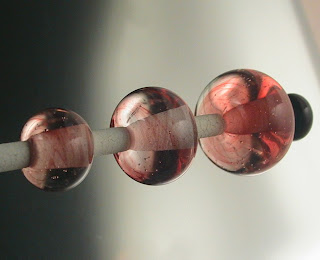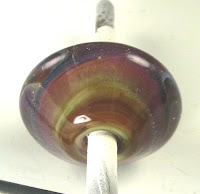
Sheesh! Talk about a tough crowd! It's not real if there's no pictures? (see comments re last post.)
OK - here's your proof. First up - the beads that I made on the first night.


The mandrel in front is a bunch of beads made with Double Helix Luna 2, and/or Double Helix Khaos. Sorry - can't tell you which is which. The cylinder bead I encased, and you can see in the close up that I burned the s--t out of the encasing - although, in fairness - it was a scuzzy piece of random, cr-ppy clear that was lying around on the desk. The pink spacers were a nice fat rod of laucha opaque pink, and the two in the back ground were also Luna 2, but made on the old torch, the Mega. There is definitely more colour in the bead made on the new torch - because, I believe - I could get the glass hotter and for longer. This glass was seriously dripping off the rod.

Next - the torch itself. Here you see it from the left, and from the right, against the general background clutter of my work area.
Note, there are only two hoses, but four valves. There is just one gas hose and one oxygen hose. As with the Minor and the Mega, the red knobs are for gas, and the silver knobs are for the oxygen. The graceful swoops of copper tubing carry the gas and oxygen forward to where they need to go.

It all could look a little overwhelming and intimidating - but if you've already being using a Minor or Mega - you can discount the controls for the top torch (which you already know how to use) - and just focus on the other set of controls - which work the same way.
(BTW - you don't have to get one with the top-mounted torch - that's an "optional extra.")

One thing I forgot to mention in my last post - when I fired the mid-range up for the first time - it smoked and bubbled at little at the seam here - where I'm pointing with my finger. A quick call confirmed that this is normal with this torch when it is new - and may go on for up to a couple of hours - but probably not extend to the second day. Little wisps of smoke continued to appear for about half an hour - and that was the end of it. This is the sealant between the torch face and body heating and is perfectly normal.

Here we are - looking at the business end of the torch - the front. (At this point - the torch looks different again because I have now installed a torch-mounted marver. I'll cover that in a separate post.)
The top torch is the Mega - with the red housing, and the bottom - in brass - is the Mid-range proper. Notice it is actually two groupings of jets - a centre fire and an outer ring.

Here's a view you won't see very often - looking up at the torch from in front! Here, I have turned on and lit the gas on the mid-range, but not added in the oxygen yet.

And the same view - with the oxygen turned on. Now, we have such an intense light that the poor camera can't cope, and all you see of the flame is intense while light.

Here we are, looking down, a bit to the side, and all the camera can register is that intense, white flame.
And here, the same angle - now I've adjusted the camera to show a more accurate representation of the flame, but the rest of the image disappears in darkness.
Now do you believe? ;-)

 Northstar Glassworks - Black Pearl. This is one of the Northstar "exotic" 104 COE glasses.
Northstar Glassworks - Black Pearl. This is one of the Northstar "exotic" 104 COE glasses. These next ones are ivory with trails of Black Pearl. I reduced them more and you can see they have gone to a more yellowy green - than the intense metallic look above.
These next ones are ivory with trails of Black Pearl. I reduced them more and you can see they have gone to a more yellowy green - than the intense metallic look above.














































